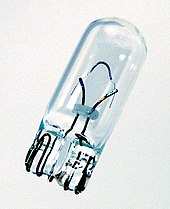Pinch foot
In glass processing , especially in vacuum technology, the pinch foot is an inexpensive method of making electrical connections between the interior of a piston and the environment in a gas-tight manner.
Applications
The pinch foot is still part of incandescent lamps and the corresponding structures in gas discharge lamps . Until the 1930s, electron tubes were only manufactured with a pinch foot.
Manufacturing
In its raw state, the pinch foot is a tube made of a glass mixture, the coefficient of thermal expansion of which is very similar to that of the special feed-through wires such as those made of the Fernico alloy .
The tube end is with a gas flame heated gently until it plastically is malleable. With a pair of pliers , the end of the pipe is not completely compressed under the influence of the flame. Now the lead-through wires are threaded and the pipe ends are finally pressed together. After the glass mass has cooled down, the wire ends are melted into the pipe connection. This process is fully automated in the industrial manufacture of lamps.
In the further course of the manufacturing process, a pump tube is often melted down below the pinch point. After the piston and pinch foot have melted together, this allows a vacuum pump to be connected in order to create the atmosphere intended for the final function in the piston.
- High vacuum for electron tubes,
- Noble gas with low pressure in incandescent lamps,
- other gas fillings for corresponding areas of application.
In the case of incandescent lamps, a glass stamp is now melted onto the compressed end, to which, in turn, retaining wires for the filament have been melted. Then the glass tube of the pinch foot is shortened to fit. The uncompressed end is expanded and fused with the piston.
Electrical connection
Metal wires are used as the electrical connection , which are well wetted by the doughy, malleable glass mass during the melting process and thus leave no notable openings for the diffusion of gas molecules.
Copper has this property, especially when it is easily oxidized. However, it has a significantly higher thermal expansion than the lead glass used for melting . With normal copper wire, this would cause a gap or cracks in the glass when it cools down due to tension . Therefore, a special copper sheathed wire is used, a core of an iron - nickel - alloy with low thermal expansion coefficient has.
Such a wire is not suitable for feedthroughs in silica glass ( quartz glass ), as required for halogen incandescent lamps and the discharge vessels of high-pressure and ultra-high-pressure gas discharge lamps . For this one uses molybdenum - film strips , which means spot welding are connected to the holding or connection wires. The welding points are located in the glass mass, so that the connecting wires get mechanical hold and the molybdenum band is enclosed on all sides by glass - this is the only way it can carry the high current without overheating.
swell
- Manufacture of an electron tube with a pinch foot (video)
- Ludwig Ratheiser: The great tube manual . Franzis-Verlag, Munich 1995, ISBN 3-7723-5064-X , construction technology of the receiver and amplifier tubes, p. 44 ff .
Individual evidence
- ↑ See electron tube # External structure for the problems here.



